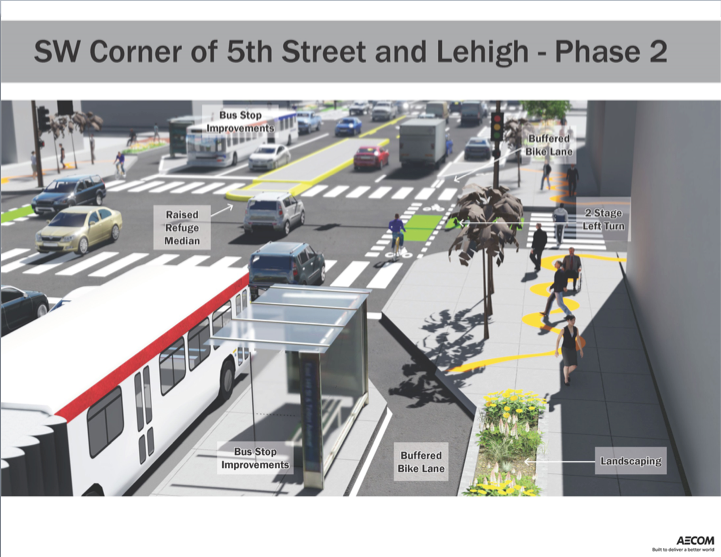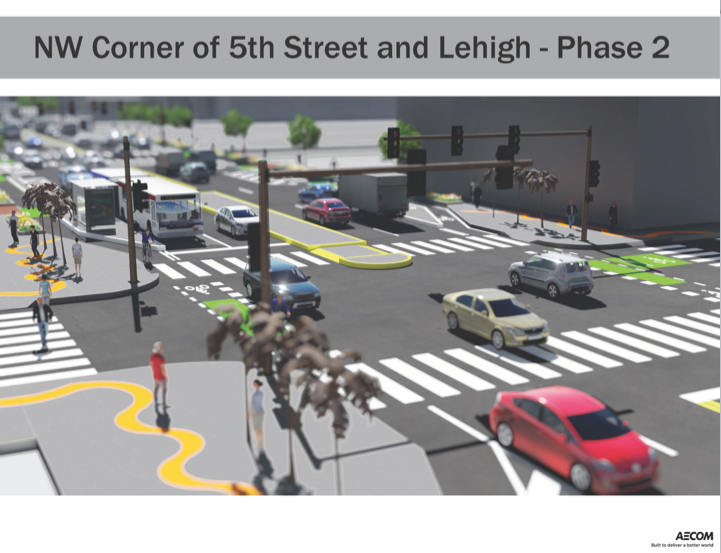
Editor’s note: The Bicycle Coalition of Greater Philadelphia’s Vision zero 2017 Conference was March 1. We will be summarizing the conference’s panels on this blog.
The second half of the Vision Zero Conference’s final session highlighted possible design plans to solve safety issues along two corridors in North and West Philadelphia. The City of Philadelphia performed street safety audits along Lehigh Avenue and South 46th and Farragut Streets with community stakeholders, and asked two engineering firms to create renderings that address potential safety improvements along the roads.
Douglas Robbins, senior planner and urban designer at AECOM spoke first regarding improvements along Lehigh Avenue in North Philly. The firm ran an analysis of the street using the safety audit and community surveys in order to identify crash clusters and other problem areas.
Most of the feedback from the Lehigh Avenue surveys reported a great deal of difficulty with pedestrian crossing. Little signage on the roads makes crossing harder, along with a lack of pedestrian facilities like bus shelters, and median refuges. Many of the problems on the avenue, according to Robbins, are problems of design; he proposed three phases of improvements starting with the shortest term solutions.

The first phase of improvements requires the least amount of major changes and expenses, focusing mainly on fresh paint and small adjustments to signs and lanes. Restriping roads to better delineate between lanes and making the signage clearer are easy and relatively cheap ways to immediately improve safety conditions on the road.
Robbins’ second phase called for larger, more long-term projects to help ease the problem of pedestrian crossing. Added green spaces such as moveable planters would help outline the perimeters of parking lot entrances that currently blend in with the rest of the sidewalk and cause safety hazards for pedestrians walking by. The second phase also suggested added lighting and bus shelters to improve the safety of pedestrians at night and in harsher weather.
The final phase of AECOM’s renderings looked at long-term goals that would have the greatest impact on the street’s safety. A buffered bike lane along the corridor, as well as pedestrian refuges between the large roadway would help make it more multi-modal, and less dominated by motorists.
A representative of Steve Chiaramonte, Lead Transportation Planner at Parsons Brinkerhoff, spoke next about their firm’s renderings for South 46th and Farragut Streets in West Philly. Most of the safety problems reported from the audit focused on visibility and lighting issues along crowded intersections, some of which can be immediately improved, according to Parson Brinkerhoff.
The intersection at 46th and Market Streets needs added visuals for pedestrian safety, as well as to better identify the Indego station located nearby. Forty-sixth and Sansom Streets also need intersection markings for pedestrian crossing. On the 46th block of Chestnut and at 46th and Walnut Streets, there is again no delineation between car and pedestrian areas; the proposed plan incorporates large, movable planers to better reveal entrances and exists to stores and restaurants on the sidewalk.
Other, smaller changes can be made to the intersection at 46th and Locust, where currently clogged inlets and overgrown trees simply require added maintenance.
